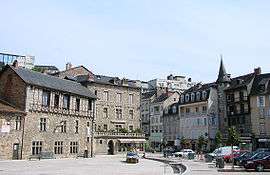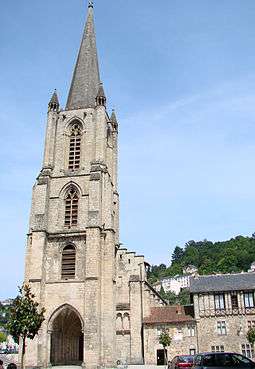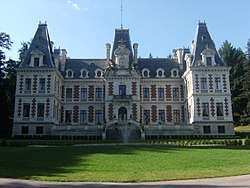Tulle
| Tulle | ||
|---|---|---|
| Prefecture and commune | ||
 A view in front of the cathedral in Tulle | ||
| ||
 Tulle Location within Nouvelle-Aquitaine region  Tulle | ||
| Coordinates: 45°16′02″N 1°45′56″E / 45.2673°N 1.7655°ECoordinates: 45°16′02″N 1°45′56″E / 45.2673°N 1.7655°E | ||
| Country | France | |
| Region | Nouvelle-Aquitaine | |
| Department | Corrèze | |
| Arrondissement | Tulle | |
| Canton | Tulle | |
| Intercommunality | CA Tulle Agglo | |
| Government | ||
| • Mayor (2008–2020) | Bernard Combes (PS) | |
| Area1 | 24.44 km2 (9.44 sq mi) | |
| Population (2014)2 | 14,325 | |
| • Density | 590/km2 (1,500/sq mi) | |
| Time zone | UTC+1 (CET) | |
| • Summer (DST) | UTC+2 (CEST) | |
| INSEE/Postal code | 19272 /19000 | |
| Elevation | 185–460 m (607–1,509 ft) | |
|
1 French Land Register data, which excludes lakes, ponds, glaciers > 1 km2 (0.386 sq mi or 247 acres) and river estuaries. 2 Population without double counting: residents of multiple communes (e.g., students and military personnel) only counted once. | ||
Tulle (French: [tyl]; Occitan: Tula [ˈtylɔ]) is a commune in central France. It is the capital of the department of Corrèze, in the region of Nouvelle-Aquitaine. It is also the episcopal see of the Roman Catholic Diocese of Tulle. It is the third-largest town in the former region of Limousin, after Limoges and Brive-la-Gaillarde.
Known sometimes as "the town on seven hills", Tulle rose to prominence through the development of its manufacturing sector.
History
Beginning
Initially, the Gauls settled an oppidum at the site of what is now the Puy St Clair because it was a site surrounded by cliffs and so easy to get off. After the conquest, the city moved downwards, to the Trech district and the Romans established a temple to honor Tutela, goddess of protection of property and persons. The name of the city comes from this goddess. She was honoured here because it was a ford over the Corrèze where passed a very old road between Brittany and the Mediterranean sea. In the seventh century was built a monastery dedicated to St. Michael. The local population settled around the buildings. The first monastery, destroyed by the Viking invasions in 846, was rebuilt but disappeared in the eleventh century.
Middle Ages

Pope Urban II, who was in Tulle in 1095, granted protection for a new religious building. The first stone of the new abbey was laid in 1130; the building was not completed until two centuries later. In 1317, Pope John XXII created the Diocese of Tulle; the abbey became a cathedral.
During the Hundred Years' War, the English took the city in 1346 and are driven from the city by the local militia, the city falls again in 1369, but English are finally expelled by the local militia again. The city was pillaged by Rodrigo de Villandrando during this time and the Black Death also affected the city but according to legend, St. Clair healed people (St. Clair is now a big fair in honour of the miracle).
Modern period
The abbey was almost abandoned with the secularization of 1514. During the wars of religion, Tulle was for Catholics, the city resisted the first time against the Huguenots in 1577, but the troops of the Vicomte de Turenne took a bloody revenge in 1585. They put the city in sackcloth and devastation, after an assault that the Protestant poet Agrippa d'Aubigne recounted.
Mutilation and looting were much more severe during the Revolution: the cathedral and the abbey buildings were converted into munitions factory, all fittings, including iron retaining the dome for recovery were torn, causing the collapse of the dome of the apse, the transept and the north gallery of the cloister. The church was reopened for worship in 1803, but only regained its title of cathedral in 1823.
Contemporary era
From 1917 to 1922, Tulle was in the spotlight of the French press because of a news item. Over 100 anonymous letters were sent, denouncing all the secrets of the inhabitants of the city. The sender was actually Angele Laval, a spurned and insane woman. This fact inspired Clouzot for his film Le Corbeau and Cocteau for his play La Machine à écrire.
Massacre by the Waffen SS in 1944
During the Second World War, the 2nd SS Division Das Reich division of the Waffen SS perpetrated a reprisal massacre of civilians in Tulle, following the killing and maiming of some 40 German soldiers in Tulle on 8 June 1944 by the Maquis resistance movement.
On 9 June 1944 a large number of male civilians were rounded up by the SS. Of these, 97 were randomly selected and then hanged from lamp posts and balconies in the town. Additionally, another 321 captives were sent to forced labour camps in Germany where 101 lost their lives. In total, the actions of the Wehrmacht, the Waffen-SS, and the SD claimed the lives of 213 civilian residents of Tulle.
Tulle Prison and the Algerian War
In the last stages of the Algerian War and its aftermath, four military officers involved in instigating a failed coup aimed at deposing President de Gaulle were held in the prison at Tulle. De Gaulle referred at the time to "those idiotic generals playing ball in Tulle Prison".[1] The four were Raoul Salan, Edmond Jouhaud, Maurice Challe and André Zeller. The last of them to be released was Salan, amnestied on 15 June 1968 in the wake of "The Events" of May 1968.
Climate
| Climate data for Tulle (1981–2010 averages, extremes 1957–present) | |||||||||||||
|---|---|---|---|---|---|---|---|---|---|---|---|---|---|
| Month | Jan | Feb | Mar | Apr | May | Jun | Jul | Aug | Sep | Oct | Nov | Dec | Year |
| Record high °C (°F) | 18.1 (64.6) |
24.8 (76.6) |
27.0 (80.6) |
30.1 (86.2) |
34.0 (93.2) |
40.0 (104) |
40.0 (104) |
40.5 (104.9) |
35.5 (95.9) |
30.6 (87.1) |
25.8 (78.4) |
20.2 (68.4) |
40.5 (104.9) |
| Average high °C (°F) | 8.4 (47.1) |
10.4 (50.7) |
14.2 (57.6) |
17.0 (62.6) |
21.0 (69.8) |
24.6 (76.3) |
27.0 (80.6) |
26.8 (80.2) |
22.9 (73.2) |
18.3 (64.9) |
12.0 (53.6) |
8.8 (47.8) |
17.7 (63.9) |
| Daily mean °C (°F) | 4.3 (39.7) |
5.4 (41.7) |
8.4 (47.1) |
10.9 (51.6) |
14.7 (58.5) |
18.0 (64.4) |
20.3 (68.5) |
20.0 (68) |
16.4 (61.5) |
13.0 (55.4) |
7.6 (45.7) |
4.8 (40.6) |
12.0 (53.6) |
| Average low °C (°F) | 0.3 (32.5) |
0.5 (32.9) |
2.6 (36.7) |
4.9 (40.8) |
8.5 (47.3) |
11.5 (52.7) |
13.5 (56.3) |
13.1 (55.6) |
9.8 (49.6) |
7.6 (45.7) |
3.2 (37.8) |
0.9 (33.6) |
6.4 (43.5) |
| Record low °C (°F) | −21.0 (−5.8) |
−16.1 (3) |
−13.0 (8.6) |
−7.0 (19.4) |
−2.0 (28.4) |
−0.5 (31.1) |
4.7 (40.5) |
2.0 (35.6) |
0.0 (32) |
−5.4 (22.3) |
−10.0 (14) |
−15.5 (4.1) |
−21.0 (−5.8) |
| Average precipitation mm (inches) | 111.5 (4.39) |
95.3 (3.752) |
94.6 (3.724) |
111.2 (4.378) |
107.6 (4.236) |
84.0 (3.307) |
79.8 (3.142) |
78.2 (3.079) |
101.1 (3.98) |
120.5 (4.744) |
122.8 (4.835) |
123.3 (4.854) |
1,229.9 (48.421) |
| Average precipitation days (≥ 1.0 mm) | 13.4 | 10.7 | 11.4 | 12.6 | 12.5 | 9.3 | 8.1 | 8.8 | 9.5 | 12.0 | 12.8 | 12.8 | 133.9 |
| Source: Météo France[2] | |||||||||||||
Economy
Tulle's role as a centre for lace making is highlighted by an "international lace festival" held each August. The town is also home to the Maugein accordion factory, which once employed 200, though this figure is now much reduced. Near to this there was, till recently, a significant armaments manufacturing business, but its site is now (2011) marked only by an armaments museum.
Located in another part of town is a car parts plant owned by the American Borg-Warner company,[3] and employing approximately 300 people.
Government

- Tulle is the seat of the general council of the Corrèze
- Tulle is the seat of the canton of Tulle, which consists of the commune of Tulle
- Tulle is the prefecture of the Corrèze department
Mayors
Mayors of Tulle since 1949 were:
- Jean Massoulier (1949–1959)
- Jean Montalat (1959–1971) for the SFIO
- Georges Mouly (1971–1977) for the RPR
- Jean Combasteil (1977–1995) for the PCF
- Raymond-Max Aubert (1995–2001) for the RPR
- François Hollande (2001–2008) for the PS (elected President of the Republic in 2012)
- Bernard Combes (2008– ) for the PS
Politics
Tulle's MP in the National Assembly of France for nearly 15 years was the Socialist François Hollande, who was elected President of the Republic in 2012. Hollande also served as mayor of the town.
Population

Cultural life
.jpg)
Education
- Normal school of teachers
- ISMIB (Higher Institute of Management of Woodworking Industries)
- IUT of Nouvelle-Aquitaine: departments Health, Safety and Environment (HSE) and Industrial Engineering and Maintenance (GIM)
- Lycée Edmond Perrier: establishment of secondary and higher education, technologic and general (1100 pupils). The school offers a Scientific CPGE (Preparatory classes schools).
- Institute of Nursing Education
- Gendarmerie training school
- CFA (Training center for apprentices) of the 13 vents
Arts and festivals
- Festival Nuits de Nacre (accordion music) since 1984 with a strong notoriety
- Festival O'les choeurs (music, theater and exhibitions) since 1997
- Festival Du bleu en hiver (jazz, rock and blues music)
- International festival of lace
- Photographic Art Festival
Museums
- Museum of the Resistance and Deportation
- Museum of Weapons
- Museum of the Accordion
Sport
The municipality has established an ambitious policy for sport in the early 2000s, which enabled it in 2008 to become the most sporting town in France. For example the town has an association football team called Tulle Foot Corrèze who concentrate on youth and first team opportunities.
Media
Tulle hosts several medias:
- Radio: France Bleu Limousin, RCF Corrèze, Bram FM
- TV: France 3 Limousin
- Newspapers: La Montagne, L'Echo, Le Populaire
International relations
Tulle is twinned with:






Personalities
Tulle is the birthplace of:
- Laurent Koscielny (b. 1985), football player
- Éric Rohmer (1920–2010), film director
- Marcelle Tinayre (1870–1948), woman of letters
- Alphonse Rebière (1842-1900), science writer
- Edmond Perrier (1844–1921), zoologist and director of the Muséum national d'histoire naturelle
- Étienne Baluze (1630–1718), scholar
- Jean-François Melon (1675–1738), economist
- Jacques Brival (1751–1820), French Revolutionary
- Thomas Domingo (b. 1985), rugby player
- Léon Eyrolles (1861–1945), politician and entrepreneur
- Charles Silvestre (1889–1948)), writer, winner of the Prix Femina in 1926
- Philippe Manoury (b. 1952), composer
- Marie-Anne Montchamp (b. 1957), Secretary of State for Solidarities and Social Cohesion
- Robert Nivelle (1856-1924), Commander-in-Chief of the French army (1916-1917)
The following people have resided in Tulle:
- François Hollande (b. 1954), the former President of France, who was elected during the French presidential election, 2012 and who previously served as Mayor of Tulle.
- Benoît Mandelbrot (1924–2010), discoverer of fractals
See also
References
- ↑ Lacouture, Jean. De Gaulle: The Ruler 1945–1970. Alan Sheridan trans. New York: W.W. Norton, 1991. ISBN 0-393-03084-9 p. 329
- ↑ "Tulle (19)" (PDF). Fiche Climatologique: Statistiques 1981–2010 et records (in French). Meteo France. Archived from the original (PDF) on 30 March 2018. Retrieved 30 March 2018.
- ↑ Voir sur le site metalcorreze.com Archived 16 January 2013 at the Wayback Machine..
External links
| Wikimedia Commons has media related to Tulle. |
- Official website (in French)
- Pictures of Tulle Cathedral: ,


